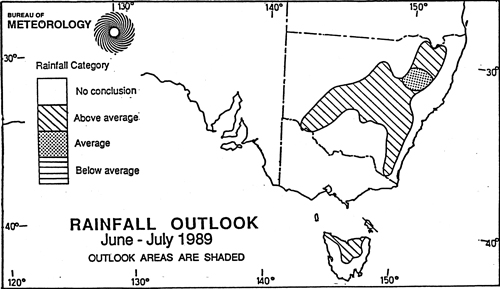Marking 25 years of the Bureau’s seasonal climate outlooks
17 September 2014
In this second article on climate outlooks, we look back on the long and illustrious history of this popular climate service—and forward to a future with the potential for ‘seamless forecasting’ linked to the Bureau’s weather forecasts.
Mid-2014 marks a special anniversary for the Bureau’s Seasonal Climate Outlook service—the point at which we have been issuing our climate outlooks for a quarter of a century.
The Seasonal Climate Outlook (SCO) service issued its first climate outlook for June and July 1989 (see figure below), with the first three-month outlook issued the following month, for July–September 1989.
The commencement of a seasonal outlook service was actually slow to happen in Australia, if you consider that the first scientific paper on prediction was written in 1929! But today, it has become one of the Bureau’s most popular climate services – with about 200,000 (product) page views each month.
A history of improvement
Among the Bureau’s many services, the seasonal outlook service stands tall as one of the best examples of continuous development and improvement. From humble beginnings, the service has steadily expanded, drawing on the scientific achievements of both our in-house climatologists and researchers, and our domestic and international peers—including CSIRO and the UK Meteorological Office.
The first climate outlooks used correlations between the atmospheric indicators of the El Niño – Southern Oscillation (ENSO), including the Southern Oscillation Index, before moving to use a mix of atmospheric and oceanic indices in the mid-1990s. This involved ‘optimal combination’ techniques, which sought the best performance among a series of statistical climate models using different climate indices, and combined these to provide the best overall forecast. Such an approach continues to be explored for so-called ‘multi-model ensembles’ in the Bureau and elsewhere.

The first climate outlook issued by the Bureau of Meteorology, providing an outlook for June and July 1989.
Improved understanding of the direct influence of sea surface temperatures (SST) on humidity and rainfall levels led to the introduction of SST-based seasonal outlooks for rainfall in 1999, with maximum and minimum temperature outlooks following in 2000. These made use of relationships with surface temperatures in both the Pacific and Indian Oceans, providing increased forecast accuracy in the autumn and winter periods when the relationships with the Pacific ENSO are weakest. The forecasts for temperature were found to be particularly ‘skilful’, achieving forecast accuracy well beyond that available for the rainfall outlooks.
But it was in May 2013 that the Seasonal Climate Outlook service made arguably its greatest leap forwards, when its statistical modelling was replaced with a ‘dynamical’ model that models physical changes in the Earth’s atmosphere, oceans, ice and land. This model, known as POAMA (the Predictive Ocean Atmosphere Model for Australia), has been shown to increase the accuracy of rainfall and maximum temperature outlooks—particularly during the unpredictable months of autumn, when the value to agriculture can be greatest.
The prospect of seamless forecasts
In development for over a decade, dynamical model outlooks show significant potential to support industries that are most susceptible to seasonal changes, such as farming and retail. Although it is more complicated than its statistical predecessor, the dynamical model offers many advantages, including an ability to better handle climate change, forecast new and unprecedented weather scenarios, and facilitate the future introduction of multi-week and monthly forecasts. Dynamical model outlooks can also provide a bridge between seven-day weather forecasts and three-month seasonal outlooks—offering the potential for future Bureau services to be seamless in time (see figure below).

A recent seasonal outlook for rainfall from the Bureau’s dynamical climate model, POAMA.
The evolution of the Bureau’s Seasonal Climate Outlook continues this month with the introduction of a more user-friendly website interface, and monthly rainfall and temperature outlooks that provide a more detailed picture of emerging conditions. The Seasonal Outlooks webpage also features short videos in which Bureau climatologists explain the outlooks and how to interpret specific climate risk information. Looking further ahead, it will also be possible to link this data to decision models such as crop pasture and crop growth models.
With continued investment and improvements in the Bureau’s modelling capabilities, the future of our seasonal climate outlooks does indeed look bright.


Comment. Tell us what you think of this article.
Share. Tell others.